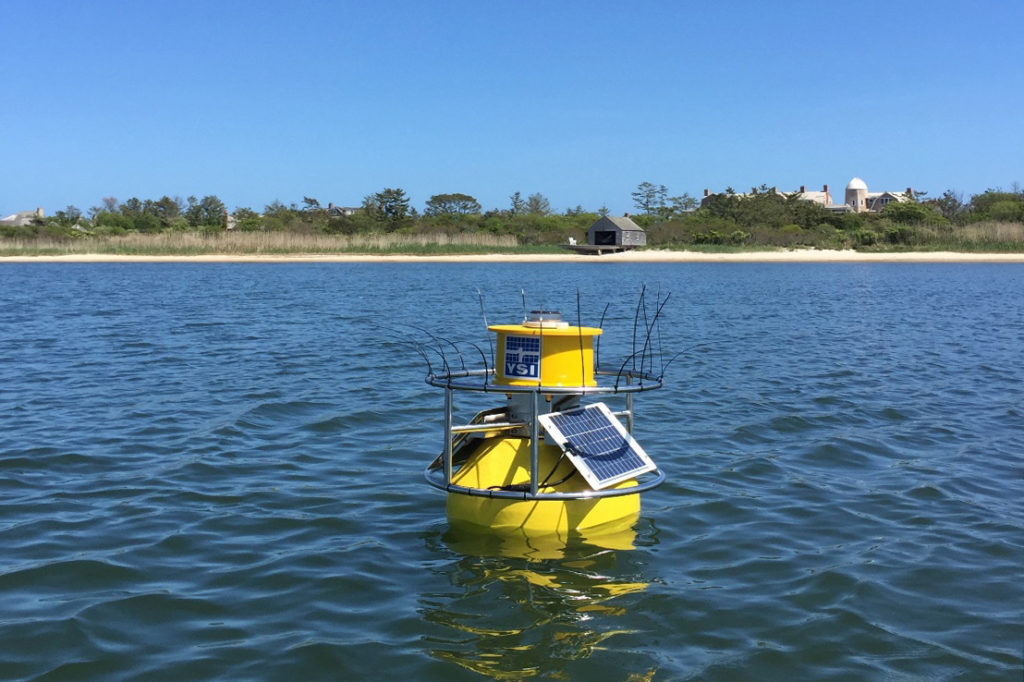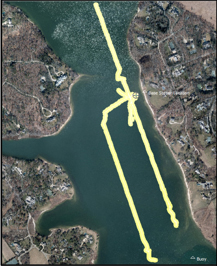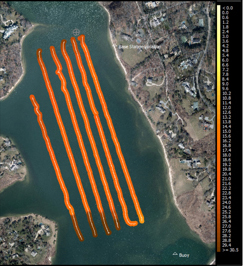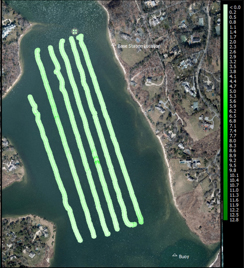Keeping a new set of eyes on Georgica Pond
By Christopher Gobler, Ph.D. Endowed Chair of Coastal Ecology & Conservation at the School of Marine & Atmospheric Sciences (SOMAS) at Stony Brook University.
We’ve entered the robotic, remote sensing age. We have speakers and phones that respond to our voice commands. We have home systems that can allow us to change the temperature or show us the sights of our home from anywhere in the world. We even have cars that drive themselves. Thankfully, the technologies that enhance our ability to observe our world remotely has also progressed in the aquatic sciences.
Telemetry Buoy

Beginning in 2015, the Gobler Lab has been ‘taking the pulse’ of Georgica Pond every 10 minutes, every year, May through November with its water quality monitoring buoy that continuously measures the temperature, salinity, dissolved oxygen, pH, and blue-green algae levels in Georgica Pond. This device has proven invaluable to detecting the sudden onset or demise of algal blooms or low oxygen conditions brought about by sudden environmental perturbations (e.g., heat waves, storms). It has even led to the realization that the water quality in the Pond at night is very different than it is during the day, a discovery with important implications for life in the Pond. Unfortunately, however, the buoy is in a fixed site, measuring conditions in the southern Pond only. While that has been adequate for defining the general conditions in the main portion of the Pond, comparisons of grab samples from the Pond, the Cove, and the sundry creeks around the Pond has demonstrated that conditions across the pond can vary significantly.
Welcome Hycat

To address this knowledge gap, in 2021, the Gobler Lab invested in a surface automated vehicle (SAV), known as the Hycat. This 6-foot by four-foot pontoon SAV can be remotely operated by a user or programmed to conduct a pre-planned mission. The Hycat is outfitted with the same sensors on the buoy, in addition to a carbon dioxide sensor, allowing for an unprecedented understanding of horizontal gradients in water quality across Georgica Pond. The utility of the Hycat was on full display last fall when missions were executed before and after the late September opening of the cut to the Atlantic Ocean.
Quantifying Effects of Pond Openings
Salinity (PSU), 9/29/2021

Salinity (PSU), 10/1/2021

Blue-green algae (µg/L),
9/29/2021

Blue-green algae (µg/L),
10/1/2021

On September 29th, 2021 a ‘before’ cruise was performed using pre-programmed cruise tracks, and the ‘after’ cruise was performed on October 1st. A comparison of the cruise tracks revealed, as expected, the sudden rise in the salinity of Georgica Pond following the opening of the cut, but also revealed a surprising non-uniform salinity distribution after the cut opening, with higher levels in the southwest and northwest relative to the southeast, possibly due to the slower emptying of Georgica Cove after the cut opens. In happy news, the cut also led to flushing out of the blue-green algae bloom that had plagued the pond since early August. Collectively, these observations have fostered a new, more nuanced understanding of the environmental conditions in Georgica Pond and will undoubtedly lead to a series of new discoveries about the Pond in the future.
So, the next time you gaze across Georgica Pond and see a small, unmanned pontoon boat cruise across the surface of the water, take it as a sign that there are scientists hard at work gathering data, even if you cannot see them.
